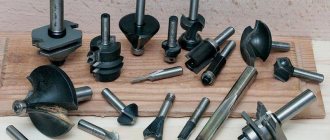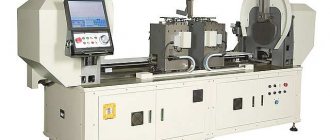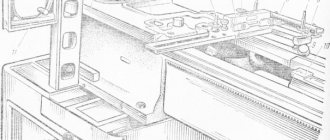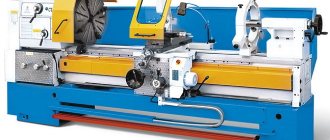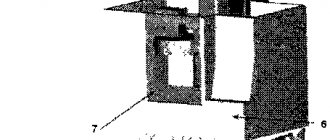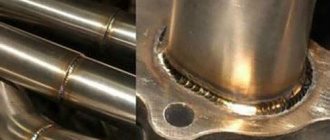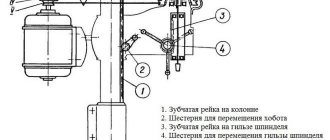Man is constantly trying to make work easier, and its results more accurate and beautiful. These or other improvements in tools apply to any tools, and even more so to machines on which products are produced for:
- industrial equipment;
- household appliances;
- complex or heavy parts required by the passenger transportation industry;
- parts of heating stations to provide the urban population with heat;
- and etc.
[Show slideshow]
Everything that concerns human life and health must be done with proper precision and accuracy. Unfortunately, even the most highly qualified masters can have a hand tremble or a hesitation in their actions for a split second, which can lead to marriage. No one is immune from this, except for the machine programmed to accurately perform the operation.
In this article we would like to talk about the main areas of refinement and improvement of lathes for metal and wood.
The first programming of looms, albeit weaving ones, was carried out at the very beginning of the 7th century. For turning equipment, a similar modernization, equipping with CNC - numerical control, occurred at the very end of World War 2. This happened in America. CNC lathes were used only to make helicopter propellers.
The computerization of the process was far from simple, and even now it is happening. Only in 1954 were machines with numerical control put into production. Nowadays, more and more, in workshops with mass production of identical products, you can find lathes with numerical control. The speed of production of parts has increased significantly on these machines, even due to the fact that the machine does not take a smoke break in the middle of the process. Defects are virtually reduced to zero, and the products are of almost perfect quality. Much depends on a properly designed program.
Not only are new machines controlled using a computer program, but old equipment can also be equipped with CNC. The goal is the same - to increase the competitiveness of products produced on old equipment. The automatic control previously installed on the machine becomes outdated over the years, new developments appear, and the wear and tear of components and parts on old machines makes itself felt over time.
When replacing or installing a CNC on a machine, the entire CCS system changes together with it - an integrated control system:
- hydraulic system;
- electric motor;
- spindle units;
- automatic machine systems;
- drives.
It is necessary to install automatic CNC control for high-precision machine tools, both for production facilities and for experimental workshops at research institutes and other organizations involved in developments in the field of precision mechanics and highly reliable technology.
RZ296 › Blog › Installing “electronic gears” on my lathe
My lathe from the factory has one inconvenient feature - the feed or thread cutting pitch is set by replaceable gears.
Changing the pitch means half an hour of installation and adjustment of the gears, then another half hour for reverse manipulations. There is also no possibility to cut left-handed threads, and autofeed is only left-handed. There is a solution: I bought a block for “electronic gears” from a forum member from chipmaker.ru, consisting of an encoder mounted on a spindle, a control unit and cables. In addition to the ability to cut any thread with an arbitrary pitch from 0.001 to 4.500 mm, a dividing head function has appeared (shows the angle of rotation of the spindle with an accuracy of 0.05 degrees), asynchronous feed has appeared from 5 to 132 mm/min and synchronous from 0.01 to 0.25 mm/rev, left and rights. All that remained was to buy a stepper motor, power supply, motor controller, toothed belt and put everything together, making gears for the toothed belt and a motor mounting plate. Installing the encoder on the spindle is, in my opinion, the most painstaking and responsible part of the installation. The encoder housing that came with the package had to be modified - the central holes in the housing itself and its cover had to be bored (the housing was made universal, so the hole was bored in place), and the mounting holes had to be drilled. The housing is attached to the PB through brass bushings 8 mm high, the encoder is mounted on a bushing that presses the rear spindle bearing, for this purpose I machined an adapter bushing from aluminum, which is attached to the above-mentioned bushing:
I determined the minimum runout of the encoder mounting flange - it turned out to be 0.03 mm, glued the disk and took a long time and carefully selecting the position of the optical sensor - the gap between the LED and the phototransistor is minimal, nothing should rub. To adjust the position, I glued electrical tape to the bottom of the sensor board and smoothly tightened the fastening screws. The wire was brought into the cavity of the PB through a drilled hole.
I hung the panel on wires, because I really wanted to check the board in operation:
I used an Omron power supply, 25 volts, 2.5 amps, designed for DIN rail installation. Deprived of a housing, the unit fit into the electrical box at the back of the machine. By adjusting the voltage, I increased the output voltage to 29 volts:
Since the control unit was made for installation on the Optimum, and my clone has a different panel, I had to make a new panel from aluminum, cover it with film and laser engrave the inscriptions I needed on it; I have a laser at work. The ammeter has also moved to the panel:
I was wondering how things were going with encoder errors, I checked it visually: I positioned the zero socket for the key vertically upward by eye, reset the spindle rotation angle counter to 0 and turned on the machine at maximum speed (1880) for 15 minutes. I turned it off and checked where 0 degrees was - in fact, the zero socket remained strictly on top. An excellent result, considering that about 28,000 revolutions were made in 15 minutes.
The manufacturing quality of the kit is very high, the encoder housing is made of plexiglass on a CNC milling machine, presumably, the control unit board is of industrial quality - with a mask, with high-quality installation.
In the meantime, they sent me a stepper motor, a driver for it and a timing belt:
I started making toothed pulleys. To do this, using a plasticine cast of the belt, I turned a Dremel cutter from St45, sharpened it, backed it, hardened it, and sharpened it some more. Works great. The Dremel was secured in a milling device using improvised means:
Later I want to make a normal mount with the ability to tilt the spindle so that I can cut worm gears. 18 tooth pulleys:
Miser pays twice
Still, it’s dishonest to say that nothing worked. There were hints of the almost correct functioning of some components. One of the SDs responded to the command to turn around with a single dull sound. The LED on the driver of this motor even glowed green up to this point, after which it switched to red. The driver of another SD defiantly glowed red immediately when power was applied and continued to stare at us like the eye of Sauron. We looked at all the wiring. We compared our version of its laying with the version in Tormach. There were no problems here. And only later, after checking the output of the CNC control board using a borrowed oscilloscope, we found the first problem: the output signal voltage rose only to half the level required by the stepper motor drivers. The board we bought for $20 turned out to be just rubbish. We decided not to skimp this time and found another board on another site that cost $99. Upon its arrival, it turned out that it was marked by another site: CNC4PC.com. At the same time, it was also 6 revisions behind the last proposed version. This board provided sufficient voltage, and we expected that the motors would work better. But they were silent...
I already mentioned that much of what we bought for our own control unit was selected from samples from an existing milling machine. These stepper motor drivers were the same MA860H model as in it. So, imagining the repair bills for this router, we began replacing the suspect parts by installing them in it. The stepper motors came first, and to our relief, both worked perfectly. Their drivers were next to be checked, and none of them were functioning anymore. The Eye of Sauron continued to mock us. Suspecting that it was our fault, we ordered a couple more drivers of the same model. Both were found to be incapacitated upon arrival. One refused to work at all in the milling machine, and the second provided rotation, but only in one direction. Obviously, these drivers were not a reliable solution.
Frankenstein motor driver: new GeckoDrives installed in a non-working driver frame
Having studied the information better on the Internet, we came up with GeckoDrive models that fully met our expectations. These boards worked great immediately after connection, and both fit perfectly into one footprint where previously there was one cheap driver. At the proper voltage, these boards required heat dissipation, which they were not equipped with by default. The remaining non-working analogs were equipped with heat sinks and fans, which turned out to be their only working part. In the end, we simply built the GeckoDrive boards into the empty frame of the dead driver, thus solving two problems at once.
Control parts assembled, but not yet housing
The new interface board was much larger than the original one, and we could now install it in place of one of the original stepper motor drivers.
A quick note about drivers: they come in analog and digital types. You can find a YouTube video comparing them in action. The video demonstrates, and we confirm, that digital versions provide much smoother and quieter engine operation. So their increased cost is justified.
Required tools and materials
To create a lathe you will need the usual tools available to every tinkerer.
- drill;
- grinder with cutting and cleaning wheel;
- welding machine;
- a set of keys;
- hand tool.
Having a router will greatly simplify the work. If there are no smooth shafts and screws from unnecessary equipment, then you will need access to a lathe.
Materials are selected from waste:
- rolled sheets of different thicknesses;
- channel;
- handles and dials;
- bearings;
- fastener
For the bed of a wood lathe, sheets of fiberboard, chipboard, and multi-layer thick plywood are used. Electric motors are suitable from an old washing machine, vacuum cleaner, or unusable power tool.
Putting it all together
Everything was in its place. We could control the motor using UI buttons or G-code instructions, and with the help of rudimentary mounting of motors to the lead screws, we could move the carriage along both axes. We didn't know the exact ratio of lead screw speed to lateral displacement, so we found the correct settings for the StepConf program through trial and error. This program asks for several values: motor steps per revolution, microstep of drivers, pulley tooth ratio, and lead screw pitch. If you are unsure of these values, keep in mind that they are multiplied into a single value, which is "steps per inch"
If all of these values except one (no matter which one) are set to 1, then in the end the remaining value will be a large number that can be adjusted with excellent accuracy
To do this, we followed the following algorithm:
- Moving from left to right, move the carriage to an approximate known position. In the CNC UI, reset the offsets by setting the position value to 0.
- Measure the location of the carriage.
- Using G-code, move the carriage 1” further to the right, that is, to Z1.
- Measure the new position of the carriage and calculate the difference in inches.
- Divide the TPI value by the distance traveled by the carriage to obtain the new TPI value. For example, if the TPI is 20,000
and you offset by
1.015”
, then the new value would be
20,000/1.015
or
19,704
TPI. - Repeat the process until the command to perform an offset of 1"
gives a specific offset of
1"
.
It is very important to take measurements after moving the carriage in one direction only, because the lead screw will likely have some play. If you take a measurement after moving in the opposite direction, the result will deviate up to the amount of play
The digital indicator was still attached to the lathe, making it much easier to compare the instructions entered into the PC with the actual movement of the carriage. By following the algorithm we developed, we needed to obtain a TPI value that would give consistent results regardless of the axis on which the measurements were taken. This approach worked fine for the X-axis, but when measuring the Z-axis, results varied by up to 0.012” depending on where the measurements were taken. There was something seriously wrong.
How to make a homemade device using wood and metal?
The creation of a CNC lathe should begin with the development of an assembly drawing and detailing. Then suitable pieces of rolled stock are selected from the “junk” for the manufacture of specific elements of the frame and other components.
Main components of a CNC lathe:
- bed with guides;
- headstock;
- spindle;
- cartridge;
- caliper;
- slide with tool holder;
- tailstock with center;
- drive unit;
- computer and control cabinet.
The housings are made of thin sheet. Supporting structures and bases are welded from rolled steel with a thickness of 8 mm or more.
Making supports
All main components are mounted on the frame. At the same time the base:
- ensures the alignment of the rotating and stationary centers;
- parallelism of the location of the guides and the axis of rotation; dampens vibration.
For a wood lathe, it is enough to take a chipboard slab with a thickness of 30–40 mm. Attach wooden beams to it from below along the ends at a distance of 10 mm from the edge. They will replace the legs when installing the machine on a table. free-standing equipment will require strong supports in the form of trapezoidal structures made of timber with inclined crossbars.
The sheet is marked for installation of the headstock, guides and motor. Holes are made and everything is attached to the supports. You can assemble the entire base together with the supports and then make holes for fasteners along the sole.
Assembling the device
The headstock, tailstock and caliper are pre-installed on the base plate. Their alignment and parallelism are checked. After this, the nodes are fixed to the frame.
- The headstock is attached to the base.
- Guides are installed.
- The lead screw is mounted.
- A caliper is installed on the guides, a screw is passed through it and secured in the coupling.
- The tailstock is exposed - the fixed center.
To process parts of different lengths, the tailstock is fixed through bushings on round guides or longitudinal grooves are made at the base of the support to move it along the axis and clamp it with bolts.
Making a 3-jaw chuck
The chuck faceplate is fastened to the spindle through a threaded or conical bushing. You can carve it yourself from wood, preferably hardwood. To do this, an electric drill is fixed in place of the spindle.
The drill is replaced with a countersink or a gear cutter for a hand router. The end of the workpiece is pressed against the tool and rotates with it. The cutter is guided by a caliper and moved transversely by a slide. Processing is carried out in manual control mode.
To connect to the faceplate, the bushing is made with a flange to fit the hole in the disk. Mark 3 grooves on the faceplate from the center exactly at 120⁰. They should not be 12–15 mm to the edge and should be at a distance of 8–10 mm from the sleeve.
Tips and tricks
CNC lathes are controlled by starting and stopping the motors. A stepper motor should be installed to feed each direction:
- spindle rotation;
- longitudinal movement of the caliper;
- lateral movement of the tool holder.
If there are other automatic feeds, each of them is connected to its own motor.
A CNC machine, even a homemade one, requires certain operating and storage conditions:
- room temperature from +10 to +25 degrees;
- humidity below 80%;
- stable voltage.
Electronics and electrical equipment are sensitive to voltage fluctuations. For stable operation of a CNC machine, it is necessary to install a voltage stabilizer.
Possible mistakes
Connecting a numerical control program to a machine is a complex and costly process. CNC will pay for itself only if large quantities of parts are produced. Manufacturing accuracy is low. Homemade equipment will be in demand when processing wood in workshops for making furniture and other products. Metal parts that require dimensional accuracy and cleanliness of processing can be manufactured manually.
When installing the main components on the frame by welding, a monolithic rigid structure is obtained. But it has its drawbacks. With a fixed connection, it is impossible to regulate the alignment of the centers and their parallel location relative to the movement of the caliper. Only guides can be welded. The headstock and tailstock must be bolted and adjustable using shims.
The center of the tailstock should rotate freely. If there is no support bearing, a ground bushing made of cast iron or bronze should be installed. A DIY lathe will cost much less than a purchased one. Designing and making it is interesting for craftsmen.
Setup diagram
The setup is carried out step by step in several stages. The sequence of steps must not be changed, otherwise the task will be completed incorrectly. There are six main setup stages:
- installation of equipment in a fixed position;
- installation of devices and working mechanisms;
- performing dimensional adjustments;
- input of control program;
- processing of a test piece;
- assessing the performance of the control program and making corrections.
It should be borne in mind that even an experienced operator cannot adjust metal-cutting devices without the need to make changes. This process is called adjustment. It represents additional adjustment in order to improve the quality of processing. If the machine was set up by a professional, he will definitely carry out adjustments and look at the errors in detail.
Messages 20
1 Topic by IgorVldv 2017-04-08 11:16:43
- IgorVldv
- Professor CNC
- Inactive
- From: Vladivostok
- Registered: 2016-06-12
- Messages: 1,049
Topic: Conversion of CNC 3020T (Chinese)
Today I received 1250mm guides and a -1250mm spigot, a complete set. The size of the machine will be Y-1250 mm, X-400 mm, Z-200 mm. Everything from the Chinese will be used except the frame. I think NEMA 17 engines will handle it.
2 Reply from nachkar1978 2017-04-08 19:27:44
- nachkar1978
- Professor CNC
- Inactive
- Registered: 2016-07-27
- Messages: 1,299
Re: Conversion of CNC 3020T (Chinese)
oh) it’s unlikely that it’s impossible to cope
3 Reply from ygordom 2017-04-08 21:51:48
- ygordom
- cnc pro
- Inactive
- From: Murmansk
- Registered: 2016-08-17
- Messages: 10,091
Re: Conversion of CNC 3020T (Chinese)
oh) it’s unlikely that it’s impossible to cope
If I'm not mistaken, this is your 23rd episode? And it seems to only work at low speeds. 17 is not an option, you will have to change it in a week.
4 Reply from Alexander Efa 2017-04-08 22:49:55
- Alexander Efa
- Experienced
- Inactive
- Registered: 2016-07-31
- Messages: 131
Re: Conversion of CNC 3020T (Chinese)
I can’t imagine how you can convert a CNC 3020T into a machine
The size of the machine will be Y-1250 mm, X-400 mm, Z-200 mm.
These machines have nothing in common: neither the caliber of the guides, nor the layout of the parts. This is just construction from scratch. at
I would look towards at least nema24 (power 3 N*m) ball screw 2005
5 Reply from IgorVldv 2017-04-11 02:56:24
- IgorVldv
- Professor CNC
- Inactive
- From: Vladivostok
- Registered: 2016-06-12
- Messages: 1,049
Re: Conversion of CNC 3020T (Chinese)
Everything will be fine with the engines. They will pull. Milling will still be at low speeds. Because the spindle is low-power. Only 300 watts. Now I just need a larger working field. PS I tried it at 2500, the cutter broke halfway through the workpiece. The blank was 250X150. Material oak. And NEMA 23-34 is already for a large machine.
6 Reply from IgorVldv 2017-08-10 13:42:43
- IgorVldv
- Professor CNC
- Inactive
- From: Vladivostok
- Registered: 2016-06-12
- Messages: 1,049
Re: Conversion of CNC 3020T (Chinese)
Today I had time and started remaking my Chinese. I assembled the frame using tacks, the geometry of the bed was done. Now you can scald it for finishing. The size will be along the x axis 41 cm. Along the y axis 120 cm. Along the z axis 19 cm. All guides and splines came from the Chinese. I only bought rail guides and a spigot kit for the y axis. Install a 50x50 corner for the guides and install the portal. I’ll post the portal later, it’s not finished yet.
Modernization of CNC turning: design of the milling part
Modernization of CNC turning in terms of design of the milling part should ensure the rigidity of the entire structure and the required range of movement of the executive body. The supporting surface of the load-bearing element will be inclined to the spindle axis, which will expand the working space and give the structure the necessary rigidity. We will design a slab measuring 954 x 105 mm and 10 mm thick as a base (Fig. 1). These values are determined by the design of the machine. At the fastening points we will model holes for screw connections.
Rice. 1. Plate of the modernized CNC machine
There should be supports on the plate that ensure the structure is tilted towards the working area of the machine. To do this, we will design two prisms and cut them with a plane located at an angle. Let's connect the prisms together and add fillets to evenly distribute the load. We will design a spike at the base of the support; it will help to accurately position the support on the slab (Fig. 2). Let's add holes at equal distances to the slab structure and create an assembly (Fig. 3).
Control unit assembly
The original unit was too small and simply would not have accommodated all the components needed to operate the machine. Therefore, we ordered a case measuring 24″x16″x10″, which would definitely fit everything. The 10" depth was perhaps excessive, but it provided plenty of space to mount cooling fans and switches on the side wall. At the same time, the case turned out to be rigid enough that, when installed on the back wall of the machine, it could hold the monitor on itself without falling.
Control Layout
We mounted all components onto a 1/8” thick sheet of aluminum that could be removed from the chassis for easy access. At the same time, it also acted as a heat sink. For the manual spindle control elements, we cut corresponding holes in the sheet and body.
Wiring
To avoid wire tangling, we added cable channels with open grooves.
Carefully marked connection
Throughout the process, the diagram was processed in Visio, where all connections were carefully numbered and wires were marked at both ends to match.
Assembled control box (with Stan's head inside)
Control unit assembly. First testing
The entire process of assembling the control unit took about 60 hours.
Design of the spindle raising/lowering mechanism
Spindle is a motor on which a chuck or collet is mounted to hold and rotate a cutting tool (cutter, drill, engraver). An industrial spindle is a specially designed device that is designed for high lateral loads, has a cooling system and lubrication. As a rule, an industrial spindle does not require lubrication or cleaning throughout its entire service life.
The spindle cooling system can be air or water. The air-cooled spindle has a fan on the rotating shaft. The main disadvantage of this design is that the fan sucks in air along with dust generated during processing. The water system does not have this drawback and is generally more efficient.
For these reasons, to modernize a CNC turning we will choose an industrial water-cooled milling spindle GDZ 0.8 (Fig. 10). Spindle power 0.8 kW. Rotation speed 0-24000 rpm. Overall dimensions: 195 x 65 mm. This spindle is suitable for milling and engraving work on wood, plastic, textolite and other materials.
Rice. 10. Spindle GDZ 0.8 water cooling
When milling, it is important that the spindle is firmly secured in position. Therefore, a worm gearbox is used as a mechanism for raising/lowering the spindle. This type of gearbox has a self-braking property, which is important when the spindle is exposed to lateral loads.
Let's choose a worm gearbox SITI MU30 (Fig. 11). The worm gearbox is equipped with a 0.9 kW motor. Its choice is determined by technical characteristics:
- Torque – 30 Nm
- Output shaft diameter – 14 mm
- Weight – 1.6 kg
- Overall dimensions (WxDxH) – 57x84x90 mm
- The worm gearbox is equipped with a 0.09 kW motor.
Rice. 11. Worm gearbox SITI MU30
Design of carriage motion drives
Brushless DC stepper motors are most widely used in CNC machines They have high reliability and long service life, high torque at low speeds and low cost. The absence of sliding electrical contacts in them increases the service life and ensures high reliability of this type of motor. The main disadvantages are the complexity of the control circuits and the loss of torque as the rotation speed increases.
To drive the carriages of the milling part of the modernized CNC lathe, we will choose a stepper motor FL86STH118-6004A. This engine has a torque of 87 Nm. Weight is 3.8 kg. Overall dimensions: 86 x 118 mm.
Rice. 12. Stepper motor FL86STH80-6004A
The carriage drives of the milling part must also be equipped with gearboxes. Planetary gearboxes, unlike worm, cylindrical and other gearboxes, have a number of advantages - alignment, accuracy, high efficiency. Due to the low backlash, they are used in CNC axes, linear motion modules, cnc drives, and actuators.
Let's choose a planetary gearbox PX86-6 (Fig. 13):
- Inlet flange - 86 mm
- Inlet - 12.7 mm
- Gear ratio - 6:1
- Reduction stages - 1
- Nominal torque - 33 Nm
- Torque, max. — 65 Nm
- Efficiency - 87%
- Backlash up to - 1°
- Radial load - 750 N
- Axial load - 380 N
Rice. 13. Planetary gearbox PX86-6
Further modernization of CNC turning involves choosing a ball screw. Ball screw transmissions are the most common type of rolling screw-nut transmission. It has all the main advantages of the sliding screw-nut transmission, and at the same time does not have its main disadvantages, such as low efficiency, increased friction losses, and rapid wear.
Structurally, a ball screw consists of a screw and a nut with helical grooves of a curved profile. The grooves serve as raceways for balls placed between the turns of the screw and nut.
Rice. 14. Ball screw (Ballscrew)
The FF carriages move along the rolling guides. Rolling guides are units designed to move the tool, workpiece and associated units along a given path with the required accuracy. Currently, several main types of guides are used in the design and construction of CNC machines: support shafts, dovetails, splined shafts and profile rail guides.
Of the types of guides considered, the most suitable for the milling part are ball rail guides. Profile rails are characterized by high accuracy and straightness, high load capacity, high wear resistance, low backlash or its complete absence. The disadvantage of profile guides is the high requirements for roughness and straightness of the mounting location, as well as the complexity of installation.
To modernize a CNC turning machine, we will choose TNK HSR-M1 guides with a height of 14 mm (Fig. 15).
Models considered
In the comparison table (see below) the selected machines are ranked by weight and size. Only their main technical parameters are given here, and the result of the analysis and our rating of tabletop metal lathes are presented in the next section.
| Stalex SBL-280/700 | Stalex SBL-250/550 | METALMASTER MML 1830V | Jet BD-8VS | Jet BD-6 | |
| Turning diameter above bed, mm | 280 | 250 | 180 | 210 | 180 |
| Center distance, mm | 700 | 550 | 300 | 400 | 200 |
| Through hole in the spindle, mm | 38 | 26 | 21 | 21 | 20 |
| Spindle speed, rpm | 50-1800 | 50-2000 | 150-2500 | 50-2500 | 100-2500 |
| Engine power, kW | 1.5 | 1.1 | 0.6 | 0.6 | 0.25 |
| Dimensions, mm | 1400×550×500 | 1100×590×500 | 830×395×355 | 890×390×310 | 600×300×300 |
| Weight, kg | 190 | 120 | 65 | 58 | 33 |
| Approximate price, rub. | 195 000 | 145 000 | 60 000 | 75 000 | 50 000 |
- Stalex SBL-280/700
Produced in China by the famous international brand Stalex. This is the heaviest and largest model from the analyzed group: its weight is 190 kg, length is 1400 mm, width is 550 mm and height is 500 mm. Main drive power - 1.5 kW. Unlike other models, its standard delivery includes two steady rests.
- Stalex SBL-250/550
Model of the same international brand, but slightly smaller in size. Its weight is 120 kg, and its dimensions are 1100 mm in length, 550 mm in width and 500 mm in height. Like all equipment of this type from the Stalex brand, it has a stepless spindle rotation regulator with electronic speed indicator. Its standard delivery includes a set of direct and reverse jaws for the lathe chuck.
- METALMASTER MML 1830V (MML 180x300V Turner)
MetalMaster is a well-known Russian-German group of engineering companies that produces metal-cutting equipment in Poland, China and Russia. MML 1830V has been produced in China since 2016 and is a modified version of the previous model of this machine. Its overall dimensions (length/width/height, mm) are 830x395x355, and its weight is 65 kg. Motor power is 600 W, control is stepless in two ranges. Includes thrust center and return cams, as well as metal guitar replacement gears.
- Jet BD-8VS
Tabletop turning equipment from the Swiss brand Jet is now available in China. Jet BD-8VS is close in size and weight to METALMASTER MML 1830V, has the same power and engine speed, but is almost a quarter more expensive than the latter. Recently, these Swiss-Chinese machines began to be equipped with a set of plastic replacement gears.
- Jet BD-6
This model is distinguished by its light weight (33 kg), compact dimensions (length - 600 mm, width - 300 mm, height - 300 mm) and low-power motor (250 W). In its layout and configuration, it is similar to the older model Jet BD-8VS.
Machine upgrade options
- Modernization of mechanical components ─ replacement of the spindle assembly, ball screws and guides, production of new brackets and platforms for mounting components, etc.
- Electronics modernization ─ replacement of CNC rack, drives, sensors, installation or replacement of optical rulers and encoders
- Modernization of electrical equipment ─ replacement of relays, starters, machines, motors, wires and cables, sensors, etc.
- Updating the appearance and space: replacing the electrical cabinet, installing a new operator console, sanding and painting machine parts, replacing safety guards and work process monitoring devices
- Updating of supply lines: replacement of hoses and lubrication pipes, pneumatic and hydraulic systems, coolant supply and filtration systems
To understand which of these options is right for you, pay attention to the following problems in the operation of your equipment:
- frequent crashes;
- impossibility of compensating for mechanical wear;
- frequent problems with contacts and wires;
- high electricity consumption;
- high level of operator participation in production;
- lengthy setup of the machine and equipment.
The scope of modernization work must be calculated based on the criteria for improving the characteristics of the machine, its downtime and the capabilities of the project budget. At your choice, you can install both complex CNC and drive systems: Fanuc, Siemens, Heidenhain, Mitsubishi, and simpler ones: Omron, BaltSystem. The same applies to sensors and electrical equipment.
The procedure for carrying out modernization work
- Diagnostics of the current state of equipment
- Development of a machine modernization project
- Coordination of technical specifications and project budget
- Selection of replacement parts from modern catalogs
- Development of electrical circuits, hydraulics and pneumatics systems
- Development of an electrical automation program and operating cycles
- Dismantling/installation of replaced components
- Updating software and setting up drives
- Checking the operation of all components, sensor activation, compliance of warning and alarm signals and messages
- Checking the geometric parameters of the machine
- Machine operator training
- Production of a test part and delivery of the project to the customer
A project for modernizing your machine, carefully developed by our specialists, will allow you to plan the work and supply of components in such a way as to minimize losses due to downtime of the equipment being modernized. For example, the assembly of a modernized electrical cabinet can be carried out both at the customer’s enterprise and at our assembly site, followed by delivery, installation and connection.
It is often advisable from the point of view of the degree of wear of components and justified from the point of view of economic and time costs to combine the repair of a CNC machine with modernization. And the end result is not just a repaired machine, but equipment with new capabilities in terms of accuracy, technological capabilities and productivity.
Our advantages:
- The qualifications of our specialists are confirmed by certificates from leading manufacturers of machine tools and CNC systems Extensive experience in the repair, adjustment and modernization of machine tools Direct contact with manufacturers of equipment and CNC systems as a guarantee of prompt and highly qualified work on the modernization of your equipment Individual approach to each customer Solving unique and complex problems tasks based on extensive experience working with hundreds of customer enterprises Free recommendations with options for the cost of modernization work Performance of work on a contractual basis Excellent price-quality ratio Discounts and bonuses when concluding long-term contracts Minimum deadlines for completing work Accepting applications 24/7 We work throughout Russia Automated monitoring of machine tools, including remote Integrated approach to solving customer problems: diagnostics ─ repair ─ monitoring ─ maintenance (MOT) ─ modernization ─ training
What devices do we repair?
The list of equipment we restore includes:
- Lathe systems.
- Milling installations.
- Grinding devices.
- Drilling units.
- Press
- Hydraulic hammers
Such devices are actively used in the metalworking industry. They significantly speed up work processes. Allows you to repair breakdowns with maximum precision. Restoration activities are carried out quickly, efficiently and thoroughly.
There are many reasons for developing a set of repair and modernization measures. It can be:
- Failure of electrical equipment.
- Control system failure.
- Technical malfunctions of the drive.
- Electronic malfunction.
- Wear of turning components, extruder and other working units.
Thanks to extensive experience and a responsible approach to the execution of orders, replacement, diagnostic and maintenance procedures are carried out on the basis of a prepared project. The locations of breakdowns are determined with minimal error. The most effective schemes for solving the problem are selected. New components with exactly the same technical parameters are selected.
The process of equipment improvement helps to increase the degree of equipment productivity. It greatly simplifies the task of implementing various systems for programming work operations. Accuracy and reliability increase, energy resource consumption decreases. The received source data is securely managed. There are real opportunities to find ways to develop entire networks that provide interoperability with other software resources.

